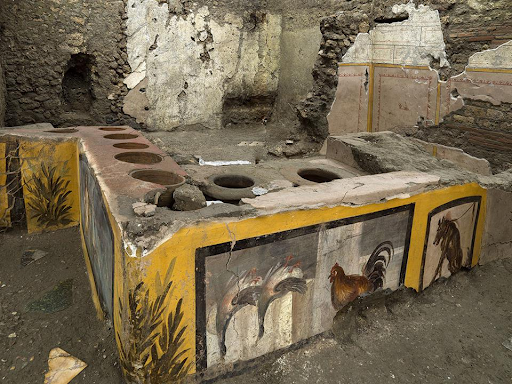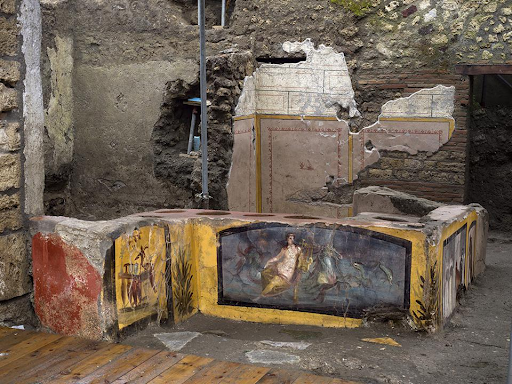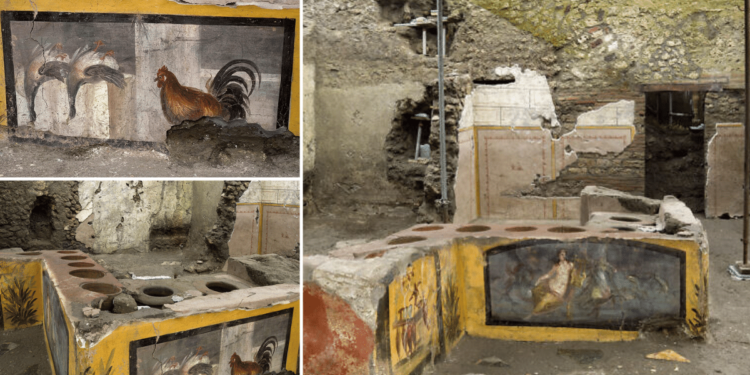A painting depicting a Nereid nymph riding a seahorse and gladiators in the fight has previously been discovered.
Archaeologists discovered a variety of still life images, including renderings of animals believed to have been on the menu, such as mallard ducks and a rooster, for presenting with wine or hot drinks, in the most recent stage of their study.
Scientists were also able to glean valuable new information on the town’s gastronomic habits dating from the eruption, which engulfed Pompeii and the neighboring town of Herculaneum as people tried to flee only to be engulfed by pyroclastic lava currents or struck by falling buildings as they tried to flee.
Duck bone pieces, as well as the remnants of pigs, goats, fish, and snails, were discovered in clay jars by the crew. Some of the items had been cooked together in the style of paella from the Roman era.
At the bottom of one jar, crushed fava beans, which are used to change the flavor of wine, were discovered.

Archaeologists continued excavating after a section of the fast-food counter was partially dug up in 2019 as part of operations to shore up Pompeii’s often-crumbling remains, exposing a multi-sided counter with typical broad holes put into its top.
Deep vessels for hot dishes, similar to soup bowls snuggled inside modern-day salad bars, sat on the countertop.
Plant and animal experts are currently examining the site’s remnants. The eatery was further enlivened by images of two upside-down mallards and a rooster, whose plumage was painted in the characteristic vibrant hue known as Pompeiian red, and presumably intended to advertise the cuisine.
Another painting portrayed a dog on a leash, maybe similar to modern-day pet leash warnings. On the frame of the picture, vulgar graffiti was scribbled.
“Initial investigations reveal how the painted representations depict, at least in part, the meals and beverages effectively offered inside,” said Valeria Amoretti, a Pompeii staff anthropological. A duck bone fragment was discovered in one of the containers, along with bones from goats, pigs, fish, and snails, according to her statement.

“We know what they were eating on that day,” Osanna stated, referring to the collapse of Pompeii in 79 A.D. The food relics revealed “what was popular among the regular people,” according to Osanna, who noted that the Roman aristocracy did not visit street-food joints.
The full skeleton of a dog was one of the unexpected discoveries. The find piqued the excavators’ interest since it wasn’t a “big, strong dog like that painted on the counter,” but rather “an exceptionally little example” of an adult dog, measuring 20 to 25 cm (8 to 10 inches) at shoulder level, according to Amoretti.
It’s unusual to find bones of such little canines from ancient times, according to Amoretti, finds that “attest to selective breeding in the Roman age to achieve this outcome.”
A bronze ladle, nine amphorae (common food containers in Roman times), a pair of flasks, and a ceramic oil container were also discovered.
Successful restaurateurs understand the importance of a good site, and the owner of an old fast-food joint appeared to have found one. Osanna saw a tiny plaza with a fountain directly outside the café, as well as another Thermopolis nearby.
The explosion of Mount Vesuvius, which is located near present-day Naples, obliterated Pompeii. A large portion of the old city has yet to be unearthed. The location is one of the most visited tourist destinations in Italy.
Human remains were also unearthed during the eatery’s excavation.
According to Pompeii officials, the bones were likely disturbed in the 17th century during clandestine excavations by robbers hunting for treasures. Authorities claimed some of the bones belonged to a guy who looked to have been resting on a bed or a cot when the Vesuvius volcano erupted since nails and bits of wood were discovered under his corpse.
Other human bones were discovered within one of the counter’s containers, perhaps dumped there centuries ago by the excavators.
Every day from 12.00-19.00, visitors can visit the historic snack bar. Massimo Osanna, Director-General of Museums, stated in a news statement that he was “delighted to see the Thermopolium available to the public, following the prompt completion of restoration work.”
He termed the find “a once-in-a-lifetime chance for multidisciplinary research that led to a better knowledge of Pompeians’ food and everyday lives.”























